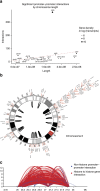An integrated model for detecting significant chromatin interactions from high-resolution Hi-C data
- PMID: 28513628
- PMCID: PMC5442359
- DOI: 10.1038/ncomms15454
An integrated model for detecting significant chromatin interactions from high-resolution Hi-C data
Abstract
Here we present HiC-DC, a principled method to estimate the statistical significance (P values) of chromatin interactions from Hi-C experiments. HiC-DC uses hurdle negative binomial regression account for systematic sources of variation in Hi-C read counts-for example, distance-dependent random polymer ligation and GC content and mappability bias-and model zero inflation and overdispersion. Applied to high-resolution Hi-C data in a lymphoblastoid cell line, HiC-DC detects significant interactions at the sub-topologically associating domain level, identifying potential structural and regulatory interactions supported by CTCF binding sites, DNase accessibility, and/or active histone marks. CTCF-associated interactions are most strongly enriched in the middle genomic distance range (∼700 kb-1.5 Mb), while interactions involving actively marked DNase accessible elements are enriched both at short (<500 kb) and longer (>1.5 Mb) genomic distances. There is a striking enrichment of longer-range interactions connecting replication-dependent histone genes on chromosome 6, potentially representing the chromatin architecture at the histone locus body.
Conflict of interest statement
The authors declare no competing financial interests.
Figures




References
-
- Sexton T. et al.. Three-dimensional folding and functional organization principles of the Drosophila genome. Cell 148, 458–472 (2012). - PubMed
Publication types
MeSH terms
Substances
Grants and funding
LinkOut - more resources
Full Text Sources
Other Literature Sources
Miscellaneous

